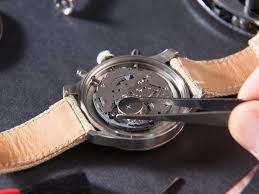What Do I Need to Know About Changing a Watch Battery?

Changing a watch battery is a relatively simple task, but it requires
care and precision to avoid damaging the watch or its components. Here's what
you need to know about changing
watch battery:
Tools and Materials:
- Watch Battery: Identify the correct
battery type for your watch. Refer to the watch's user manual, the old
battery, or the watch's case back for this information.
- Case Back Removal Tool: You'll need a tool to
open the watch case back. This can be a case back wrench, a case knife, or
a specialized opener depending on the type of case back your watch has.
- Watchmaker's Loupe or Magnifying Tool: This
will help you see the details clearly and ensure precise positioning
during the process.
- Tweezers: Use non-magnetic,
anti-static tweezers to handle the battery and other small parts.
- Dust Blower or Compressed Air: This
will help you remove dust and debris from the watch's interior.
- Battery Insulator: Some watches have a
plastic insulator that protects the battery. Ensure you have a replacement
insulator if needed.
Procedure:
- Prepare Your Workspace:
- Work on a clean and well-lit surface with
good visibility. Use a soft cloth or a watch cushion to protect the watch
from scratches.
- Identify the Case Back Type:
- Determine whether your watch has a screw-down
case back, a snap-on case back, or a unique design. Use the appropriate
case back removal tool for your watch.
- Open the Case Back:
- Use the case back removal tool to carefully
open the case back. If it's a screw-down case, turn the case back
counterclockwise until it's loose enough to remove. For snap-on cases,
insert the tool into the gap and gently pry it open. Be cautious not to
scratch the watch.
- Locate the Battery:
- Once the case back is removed, locate the
battery within the watch movement. Some watches have a plastic cover over
the battery; gently lift it if present.
- Remove the Old Battery:
- Use non-magnetic tweezers to carefully remove
the old battery from its holder. Pay attention to the battery's
orientation; note which side faces up.
- Install the New Battery:
- Insert the new battery into the holder with
the correct polarity (positive and negative sides facing the right way).
Use the tweezers to handle the battery to avoid touching it with your
fingers.
- Replace the Battery Insulator (if
applicable):
- If your watch has a plastic insulator, place
it over the new battery.
- Close the Case Back:
- Carefully position the case back over the
watch and use the case back removal tool to close it. For screw-down
cases, turn it clockwise until snug. For snap-on cases, press down evenly
until it snaps into place. Ensure it's securely closed to maintain water
resistance (if applicable).
- Check the Watch:
- Check that the watch is functioning
correctly, and the hands are moving as they should. Verify that the watch
is keeping accurate time.
- Dispose of the Old Battery Properly:
- Dispose of the old battery according to local
regulations and environmental guidelines. Many watch battery retailers
accept old batteries for recycling.
Remember that some watches may have additional complications or require
specific instructions for battery replacement. If you're unsure about any step
or have concerns about damaging your watch, it's best to consult a professional
watchmaker or watch technician for assistance.
What Are the Best Watch Battery Types?
The best watch
battery types for your timepiece depends on
the watch's specific requirements, including size, voltage, and chemistry.
Common watch battery types include silver oxide batteries, lithium batteries,
and alkaline batteries. Here's an overview of each type:
- Silver Oxide (SR):
- Silver oxide batteries are the most common
and widely used watch batteries.
- They have a stable voltage output, making
them suitable for precise timekeeping.
- Silver oxide batteries are available in
various sizes, including SR41, SR626SW, SR920SW, and more.
- They are ideal for analog watches and most
digital watches, including quartz movements and some mechanical watches.
- Lithium (CR):
- Lithium batteries are known for their
long-lasting power and low self-discharge rate.
- They are commonly used in digital and sports
watches, as well as some high-end analog watches.
- Lithium batteries are available in sizes such
as CR2032, CR2025, and CR2016.
- They are a good choice for watches with extra
functions like backlighting, alarms, and GPS.
- Alkaline:
- Alkaline batteries are less common in watches
but may be used in some low-cost models.
- They have a higher voltage than silver oxide
or lithium batteries, which can affect a watch's timekeeping accuracy.
- Alkaline batteries are typically found in
larger watches or children's watches.
- While they are more affordable, they may not
provide the same level of precision as silver oxide or lithium batteries.
- Zinc-Air:
- Zinc-air batteries are used in some analog
and digital watches.
- They are known for their high energy density
and long shelf life.
- These batteries have tiny holes in the casing
that allow air to enter, activating the battery when the seal is removed.
- They are available in various sizes, such as
PR41 and PR44.
When choosing the best watch battery type, it's crucial to consult your
watch's user manual or check the existing battery to determine the correct size
and voltage requirement. Using the wrong type of battery can affect the watch's
performance or even damage it. Additionally, consider factors like longevity
and the specific features of your watch, as some batteries may offer better
performance in certain situations.
Lastly, for watches with water resistance ratings, it's essential to
replace the battery and reseal the case properly to maintain the watch's
water-resistant properties. If you're unsure about which battery to use or how
to replace it, consider seeking assistance from a professional watchmaker or
watch technician.
Post Your Ad Here
Comments